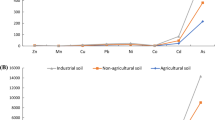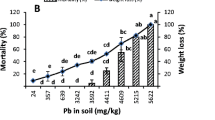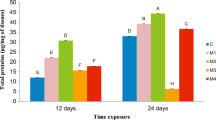Abstract
The objective of this study was to assess the capability of earthworms from the same ecological group as heavy metal bioindicators. Three earthworm species from the endogeic group were studied: Aporrectodea caliginosa (Savigny, 1826), Perelia kaznakovi (Michaelsen, 1910) and Octolasion lacteum (Örley, 1885). Their accumulation of the heavy metals lead (Pb) and cadmium (Cd) were studied from three stations in Tehran province, Iran. O. lacteum was used to compare metal accumulations in two sites located next to a highway. A. caliginosa and P. kaznakovi were used at a third site located near the edge of a sewage system to compare metal accumulations between the two endogeic species in this area. At both locations, the concentrations of Cd and Pb in earthworms were higher than in the surrounding soil. The results of the study revealed that P. kaznakovi and A. caliginosa were better bioindicators for Pb, but O. lacteum was a better bioindicator for Cd. These earthworms can therefore be used as Cd and Pb bioindicators in environmental assessment.


Similar content being viewed by others
References
Ash CDJ, Lee DL (1980) Lead, cadmium, copper and iron in earthworms from roadside soil. Environ Pollut 22:59–68
Csuzdi C, Zicsi A (2003) Earthworms of Hungary. Hungarian Natural History Museum, Systematic Zoology Research Group of the Hungarian Academy of Sciences, Budapest
Edwards CA (2004) Earthworm ecology. St. Lucie Press, Boca Raton (FL)
Ernst G, Zimmermann S, Christie P, Frey B (2008) Mercury, cadmium and lead concentrations in different ecophysiological groups of earthworms in forest soils. Environ Pollut 156:1304–1313
Esen C, Balci A (2008) Application of microwave–assisted digestion to trace heavy metal determination in sea sediment sample. J Biol Chem 36:123–128
Fründ HC, Butt K, Capowiez Y, Eisenhauer N, Emmerling C, Ernst G, Potthoff M, Schadler M, Schrader S (2010) Using earthworms as model organisms in the laboratory: recommendations for experimental implementations. Pedobiologia 53:119–125
Greig-Smith PW, Becker H, Edwards PJ, Heimbach F (1992) Ecotoxicology of earthworms. Intercept, Andover
Langdon CJ, Piearce TG, Meharg AA, Semple KT (2003) Inherited resistance to arsenate toxicity in two populations of Lumbricus rubellus. Environ Toxicol Chem 22:2344–2348
Latif R, Malek M, MacKenzie K (2011) Eiseniella tetraedra (Savigny,) (Oligochaeta: Lumbricidae) as abioindicator of heavy metals. Toxicol Environ Chem 8:1643–1649
Lowe CN, Butt KR (2007) Earthworm culture, maintenance and species selection in chronic ecotoxicological studies: a critical review. Eur J Soil Biol 43:281–288
Lukkari T, Taavitsainen M, Vaisanen A, Haimi J (2004) Effects of heavy metals on earthworms along contamination gradients in organic rich soils. Ecotoxicol Environ Saf 59:340–348
Ma WC (1982) The influence of soil properties and worm-related factors on the concentration of heavy metals in earthworms. Pedobiologia 24:109–119
Morgan JE, Morgan AJ (1999) The accumulation of metals (Cd, Cu, Pb, Zn and Ca) by two ecologically contrasting earthworm species (Lumbricus rubellus and Aporrectodea caliginosa): implications for ecotoxicological testing. Appl Soil Ecol 13:9–20
Neuhauser EF, Cukic ZV, Malecki MR, Loehr RC, Durkin PR (1995) Bioconcentration and biokinetics of heavy metals in the earthworm. Environ Pollut 89:293–301
Nieboer E, Richardson DSH (1980) The replacement of the nondescript term ‘‘heavy metal’’ by a biologically and chemically significant classification of metal ions. Environ Pollut 1:3–26
Paoletti MG (1999) The role of earthworms for assessment of sustainability and as bioindicator. Agric Ecosyst Environ 74:137–155
Peijnenburg WJGM, Vrijver MG (2009) Earthworms and their use in eco(toxico)logical modeling. In: Deviller J (ed) Ecotoxicol modeling. Springer, Heidelberg, pp 177–204
Van Gestel CAM (2008) Physico-chemical and biological parameters determine metal bioavailability in soils. Sci Total Environ 406:385–395
Acknowledgments
The authors would like to thank University of Tehran and National Science Foundation of Iran for providing financial support. Thanks are extended to Dr. Kenneth MacKenzie for English editing of the manuscript and Mr Kazemi for his help with sampling.
Author information
Authors and Affiliations
Corresponding author
Rights and permissions
About this article
Cite this article
Latif, R., Malek, M. & Mirmonsef, H. Cadmium and Lead Accumulation in Three Endogeic Earthworm Species. Bull Environ Contam Toxicol 90, 456–459 (2013). https://doi.org/10.1007/s00128-012-0941-z
Received:
Accepted:
Published:
Issue Date:
DOI: https://doi.org/10.1007/s00128-012-0941-z




